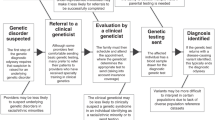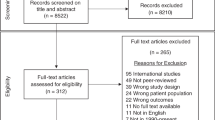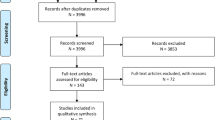Abstract
Purpose
We analyzed the patients served by the University of Washington Adult Genetic Medicine Clinic (UWAGMC) over a 42-year period to determine how clinical services have changed and to evaluate the contributing factors.
Methods
We conducted a retrospective survey of patients seen by UWAGMC that included patients seen from 1975 to 2016. Variables considered included referral indication, disease status, and clinic visit date. Indications for referral were then binned into clinical categories for descriptive analysis.
Results
Of 30,780 patient visits during the 39 years for which data were available, 57.3% occurred in the last decade. Referrals for breast/ovarian cancer or colon/endometrial cancer account for 74.8% of cancer referrals since 1998. Huntington disease patients made up 46% of neurological referral indications. Telephone screening implemented in 2013 has reduced the number of referrals for hypermobile Ehlers–Danlos syndrome.
Conclusion
Referral indications increased with clinical testing availability and because of the academic programs of UWAGMC providers. With increased public awareness of heritable conditions, prescreening self-referrals were used to allocate limited resources. These trends demonstrate the need for more geneticists in adult medicine to expand centers of excellence for rare diseases and to serve the increasing numbers of adult patients with genetic conditions.
Similar content being viewed by others
Introduction
The University of Washington Adult Genetic Medicine Clinic (UWAGMC) was founded by Dr. Arno G. Motulsky in 1959. The number of patients served has increased from fewer than 200 annually in the early 1970s to approximately 2500 patients, with a majority from the western states of Washington, Wyoming, Alaska, Montana, and Idaho. Medical geneticists and genetic counselors work together in a general genetics clinic and seven specialty clinics: Autism Genetics, Cancer Genetics, Cardiovascular Genetics, Connective Tissue Disorders, Inherited Skin Disorders, Neurogenetics, and a Turner Syndrome Clinic. They provide families with state-of-the-art genetic evaluation and access to expert management, support, and education. Partnerships with the Muscular Dystrophy Clinic, the Seattle Cancer Care Alliance, the Regional Heart Center for Cardiovascular Genetics Clinic, and the Harborview Medical Center for Memory Disorders Clinic, Kidney Genetics Clinic, and Vascular Genetics Clinic enable integrated care of patients in additional multidisciplinary specialty clinics.
Of physicians currently certified by the American Board of Medical Genetics and Genomics, only 11% are certified in internal medicine, a sharp contrast with pediatric geneticists (64%) and obstetrics geneticists (16%), a disparity that was not always this large.1 In the 1950s, prominent leaders of medical genetics were internists, including Arno Motulsky at UW, Victor McKusick at Johns Hopkins, and Leon Rosenberg at Yale. With advances in cytogenetics in the 1960s and 1970s, chromosomal anomalies that presented in childhood led to the flourishing of pediatric genetics. Development of technology to detect inborn errors of metabolism further tipped the field of genetics toward a pediatric perspective.2
The launch of the Human Genome Project in 1990 increased the impact of genetics not only in pediatrics but also in adult-onset diseases. The discovery of the gene for Huntington disease in 1993 and the BRCA1 gene for hereditary breast and ovarian cancer in 1994, followed by numerous other genes for adult-onset diseases has led to a rapid expansion in the ability to test for adult-onset genetic conditions. In a survey of 220 internists, 44% had ordered genetic testing in the last 6 months, whereas only 53.4% knew of a geneticist to whom to refer patients.3 Yet, there is a paucity of published data about adult genetics clinics.
In the 1970s, Bird and Hall found that 54% of the patients seen in the UWAGMC were seen for neurogenetic diseases, with the most common being Huntington disease, chromosomal diseases, muscular dystrophies, congenital central nervous system (CNS) anomalies, mental retardation, spinocerebellar degeneration, and neurofibromatosis.4 More recently, Eble et al. reported on 7 years of experience in an adult genetics clinic at Baylor College of Medicine. There were a total of 1552 patients seen: 35% for cancer indications, 22% for neurological/neuromuscular indications, 13% for cardiovascular indications, and 8% for chromosomal or syndromic indications.5 Although the American College of Medical Genetics and Genomics (ACMG) estimates there is one full-time clinical geneticist per 600,000 people in the United States, the National Institutes of Health (NIH) estimates that 1 in 10 Americans are living with a rare disease.6 The last major survey of the medical genetics workforce in 2003 concluded that the state of the workforce was critical, with shortages of medical geneticists in at least 17 states.7
To understand the areas in which adults’ genetic questions arise, we analyzed the referral indications over 42 years in a primarily adult genetics clinic that serves one quarter of the total landmass of the United States.
Materials and methods
The patient population includes all those seen at the UWAGMC, including the specialty clinics, from 1975 to 2016 (except for the years 1979, 1983, and 1993, for which data were missing). Clinic schedules prior to 1975 were not available for analysis. This study was deemed exempt from institutional board review by the Human Subjects Division of the UW. Data were obtained from the annual clinic reports, which are provided to the Division, UW Medical Center, and the Washington State Department of Health. Patients who canceled or missed their appointment were excluded. The two variables of interest were the indication for and the date of referral. The referral indications were binned by year into the following 11 clinical categories for descriptive data analysis: Muscular Dystrophy, Neurological disorders, Connective Tissue disorders: Vascular Subtype, Other Connective Tissue disorders, Eye and Skin diseases, Metabolic/Biochemical diseases, Chromosomal/Intellectual Disability disorders, Cancer disorders, Hematological disorders, and General Genetic disorders. Because this chart review is retrospective and the data de-identified prior to access, problems with individual records, such as the missing data or incorrect data entry, are potential sources of error.
Results
Records were obtained from 1975 to 2016, excluding the years 1993, 1983, and 1979 for which data were missing. Over this 42-year period, a total of 30,780 patient visits were documented for 39 years of clinic visits, with 57.3% (17,627/30,780) of those visits occurring in the last 10 years (Fig. 1). Categories and examples of common referral indications are shown in Table S1.
Patients seen at the University of Washington Adult Genetic Medicine Clinic (UWAGMC) from 1975 to 2016 binned into categories from Table S1.
In 1975, neurological and general genetic conditions were the major referral indications (Fig. 1). By the mid-1980s, vascular connective tissue disorders grew to dominate general genetics. In 1984, Robin Bennett was hired as the first genetic counselor in the Clinic, and brought skills and insights from the field of genetic counseling to the care of patients. After 1998, the growth changed, from increasing by 20–40 patient visits annually to increasing at the rate of hundreds of patients annually. The number of clinic visits for cancer syndromes and neurological disorders accounted for the bulk of this increase; cancer syndromes accounted for 47.8% of referrals for the last decade whereas neurological conditions accounted for 20.7% of referrals.
For cancer syndromes, most visits since 1998 were for either a personal diagnosis or familial history of breast cancer or colon cancer (Fig. 2a). Referrals for breast/ovarian cancer or colon/endometrial cancer account for 74.8% of cancer referrals since 1998. In contrast, referrals for von Hippel–Lindau disease have been stable or have increased modestly since the early 1990s.
(a) Cancer patients seen between 1990 and 2016 binned further by diagnosis/syndrome indicated in clinic notes. Patients with complex cancer presentations or multiple indications for referral were excluded, which accounts for the discrepancy between total number of patients seen for cancer indications (as seen in Fig. 1) and the sum of patients referenced here. (b) Number of patients seen for Huntington disease with symptomatic, presymptomatic, or unknown disease status since 1975. Identification as “symptomatic” or “presymptomatic” were updated with each visit. Growth in number of symptomatic patients reflects new patient referrals as well as transition of patients from presymptomatic to symptomatic status over time. (c) Number of patients seen for vascular connective tissue disorders relating to the Ehlers–Danlos syndrome (EDS) subtypes. FAP familial adenomatous polyposis.
Huntington disease is the most common reason for neurogenetic referral. Over time, the diversity of indications for neurogenetics referral grew to encompass movement disorders, neuropathy, leukoencephalopathy, muscular dystrophy, spastic paraplegia, epilepsy, and dementia. In 2009, the number of referrals for spinocerebellar ataxia increased to approximately 10% of neurological referrals. Since 1975, referrals to the UWAGMC for muscular dystrophy have increased at a pace reflecting population growth, with most patients followed thereafter in Muscular Dystrophy Clinics in the Department of Neurology.
Patients seen for heritable cancer syndromes are typically seen once or twice in the Genetics Clinic, and then followed by oncology specialists. In contrast, the UWAGMC serves as the medical home for patients with rare genetic disorders. For example, the UWAGMC is a designated Huntington Disease Society of America Center of Excellence. The clinical status for each Huntington disease patient was collected from 1975 to 2016 and recorded as symptomatic, presymptomatic, or unknown (Fig. 2b). By 2000, symptomatic Huntington disease patients had doubled to 40 patients a year, and has increased to a total of 120 patients annually. Since 2000, patients being seen yearly for presymptomatic Huntington disease and for initial diagnostic evaluation has remained constant at 40 patients and 10 patients respectively.
Another population specifically tracked over time by the UWAGMC was patients referred for Ehlers–Danlos syndrome (EDS). When referred by a provider, the patient’s referral often included which EDS subtype was suspected. If the patient was self-referring or if the provider did not list an EDS subtype, the patient’s referral was labeled EDS Uncategorized. Patients referred for all subtypes or for unknown subtype tended to increase yearly until 2013 (Fig. 2c). After 2013, patients referred by physicians for hypermobile EDS or self-referred with suspected hypermobile EDS were screened by trained staff to identify those for which the differentiation from other types of EDS was clinically important or to identify those with family histories amenable to gene discovery. The resources of the clinic were refocused on those consults with complex genetic questions, rather than those seeking confirmatory diagnostic opinion or supportive care often requested by this group. The geneticists worked with the local support group to facilitate meetings that provided guidance for individuals with hypermobile EDS. These groups have provided an alternative to individual clinic visits and facilitate group discussions about other care options in the community. Even with this screening, referrals for vascular EDS continue to increase.
Discussion
The yearly census at the UWAGMC has increased tenfold since 1975, which reflects both the change in demand for genetics services, and the scope of practice over a 42-year period. Several trends are notable, including over half of all patients have been in the past 10 years, and cancer genetics followed by neurogenetics have become the major indications for referral. The growth of the UWAGMC underscores the need for all medical genetics services for adults, but particularly for physicians with internal medicine, neurology, and oncology training in the field of medical genetics. Several factors contributed to these changes. One is the availability of molecular testing for adult-onset disease. This impact can be seen in the correlation of increased referrals for specific cancer syndromes with the onset of genetic testing. Referrals for breast and ovarian cancer began to increase in 1998, the year that BRCA testing became clinically available. Colorectal cancer syndrome referrals began to increase in 2005, shortly after testing for Lynch syndrome and familial adenomatous polyposis became clinically available. The dramatic rise of cancer genetics referrals after the mid-1990s led to a shift toward a subset of these patients being seen primarily by genetic counselors. This allowed for both an increase in the total numbers of patients seen, as well as enabled the physicians to see more complex patients, and those requiring medical management. As demand increases, additional innovative methods to deliver high quality genetics services to greater numbers of patients, and to those outside metropolitan areas, are required. This need for adult geneticists is compounded by the fact that patients with many genetic conditions are living longer. Adults with genetic disorders often look to centers of excellence, such as the UWAMGC, for lifelong care because of their perception that the clinicians are experts on the condition, and provide care not available elsewhere. Further investigation into issues associated with the transfer of care from pediatric hospitals to the adult setting for patients with complex genetic conditions unfamiliar to most adult providers, such as congenital heart disorders, neurological disorders, metabolic disorders, and connective tissue disorders, is needed.
The UWAGMC specialty clinics were established to accommodate the academic interests of the faculty, and were another reason for an increase in referrals. This is true for the Huntington disease patients seen by Dr. Thomas Bird and the connective tissue disease patients seen by Dr. Peter Byers. The longitudinal and multigenerational follow up of families has been a unique service and a rich source of clinical and research material. The UW is continuing to expand genetics services into new areas, by collaborating with the Division of Cardiology to create a Cardiovascular Genetics Clinic in 2010, with the Division of Vascular Surgery to create a Genetic Vascular Clinic in 2017, and with the Nephrology Division to create a Kidney Disease Genetics Clinic in 2018. Nationally, interdisciplinary clinics involving medical geneticists and genetic counselors with specialists in neurology, cardiology, oncology, gastroenterology, craniofacial surgery, etc. are becoming common as indicated by the 30 subspecialty categories of clinics listed under the ACMG Medical Genetics Clinic Search Engine (accessed on 14 June 2018 at www.acmg.net). Additionally, greater awareness on the part of the patients and their providers has increased demand for genetics services. Finally, patients concerned by their results from direct-to-consumer tests seek guidance.
Predicting how yet-to-be-discovered technologies will change the scope and demand for genetics services in the future is challenging. Recognition of the importance of genetic evaluation for patients in midlife and even late adulthood is growing.4 As the UWAGMC enters its 60th year, clinical practice will continue to grow and evolve, and innovative strategies to manage increased patient flow to providers serving adult patients will be required.
References
The American Board of Medical Specialties. Cross-certification summary, 2017: diplomates currently certified by the ABMGG and other ABMS member boards. http://www.abmgg.org/pdf/ABMGG_CrossCertCounts_ActiveAlive_022072018.pdf. Accessed 1 January 2017.
Rimoin DL, Hirschorn H. A history of genetics in pediatrics. Pediatr Res. 2004;56:150–159.
Klitzman R, Chung W, Marder K, et al. Attitudes and practices among internists concerning genetic testing. J Genet Couns. 2013;22:90–100.
Bird TD, Hall JG. Clinical neurogenetics a survey of the relationship of medical genetics to clinical neurology. Neurology. 1977;27:1057–1060.
Eble TN, Nagamani SCS, Franco LM, Plon SE, Blazo M, Dhar SU. The practice of adult genetics: a 7-year experience from a single center. Am J Med Genet A. 2013;161:89–93.
U.S. National Library of Medicine, National Institutes of Health. FAQ about rare diseases. https://www.genome.gov/27531963/. Accessed 28 May 2018.
Cooksey JA, Forte G, Benkendorf J, Blitzer MG. The state of the medical geneticist workforce: findings of the 2003 survey of American Board of Medical Genetics certified geneticists. Genet Med. 2005;7:439–443.
Acknowledgements
E.A.G. was supported by the ACMG Foundation Summer Scholars Program. We thank Elisabeth Rosenthal for assistance with Fig. 1. We thank Debbie Olson for assistance in obtaining the clinic schedules, and thank the many fellows, genetic counselors, nurses, and social workers, past and present, who contributed to the UWAGMC.
Author information
Authors and Affiliations
Corresponding author
Ethics declarations
Disclosure
The authors declare no conflicts of interest.
Electronic supplementary material
Rights and permissions
About this article
Cite this article
Gay, E.A., Byers, P.H., Bennett, R.L. et al. Trends over 42 years in the Adult Medical Genetics Clinic at the University of Washington. Genet Med 21, 1457–1461 (2019). https://doi.org/10.1038/s41436-018-0329-5
Received:
Accepted:
Published:
Issue Date:
DOI: https://doi.org/10.1038/s41436-018-0329-5
Keywords
This article is cited by
-
Retrospective assessment of barriers and access to genetic services for hereditary cancer syndromes in an integrated health care delivery system
Hereditary Cancer in Clinical Practice (2022)





